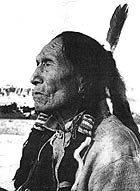Oglala Sioux Indian (1863-1950)

Black Elk was an Oglala Sioux holy man and distant cousin of Crazy Horse. He was born near the Little Powder River in Wyoming and as a teenager he fought in the Battle of the Little Big Horn in which General George Armstrong Custer and his soldiers perished. In 1877, Black Elk was taken by his family into Canada after Crazy Horse’s death. Then, he and his family were placed on a South Dakota reservation after the surrender of Sitting Bull.
He joined Buffalo Bill Cody’s Wild West show (Sitting Bull, too, had been a member a year earlier) and with it, traveled throughout the U.S. and Europe. He returned from an overseas tour just in time to witness the tragedy at Wounded Knee on the Pine Ridge Reservation in South Dakota in December 1890.
Black Elk shall always be remembered for his mysticism, healing powers and vision. He was visited in 1930 on the reservation by poet John G. Neihardt who translated Black Elk’s memoirs and in 1932 published them into a book called “Black Elk Speaks”. Carl Jung, the famous philosopher praised the book as an important contribution to the field of philosophy. In 1947, at the age of 84 he was one of the few surviving Sioux to have firsthand knowledge of tribal customs and its teachings. As a result, Black Elk agreed to have an anthropologist named Joseph E. Brown translate his remembrances of Sioux ceremonies and ways and this became the second Black Elk book called “The Sacred Pipe”. It was published in 1953, three years after the death of Black Elk.
“Oh hear me, Grandfather, and help us, that our generation in the future will live and walk the good road with the flowering stick to success. Also, the pipe of peace, we will offer it as we walk the good road to success. Hear me and hear our plea.” – Black Elk





